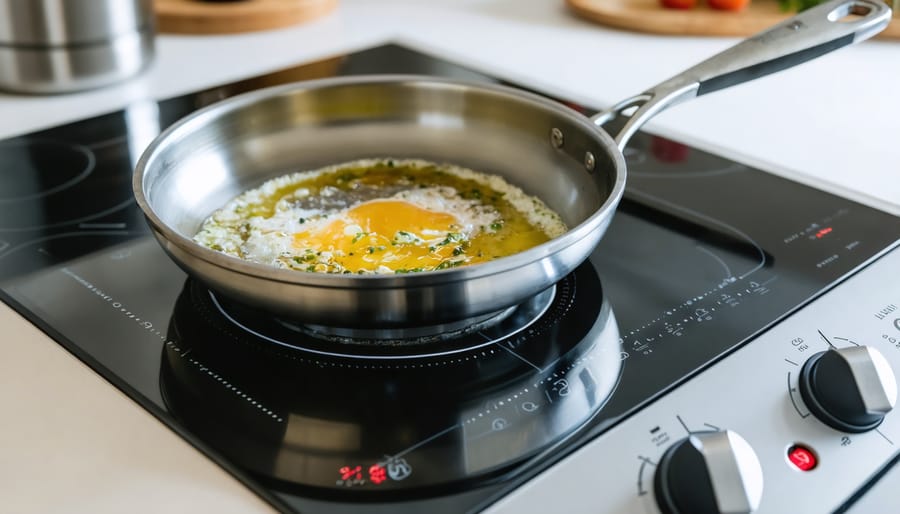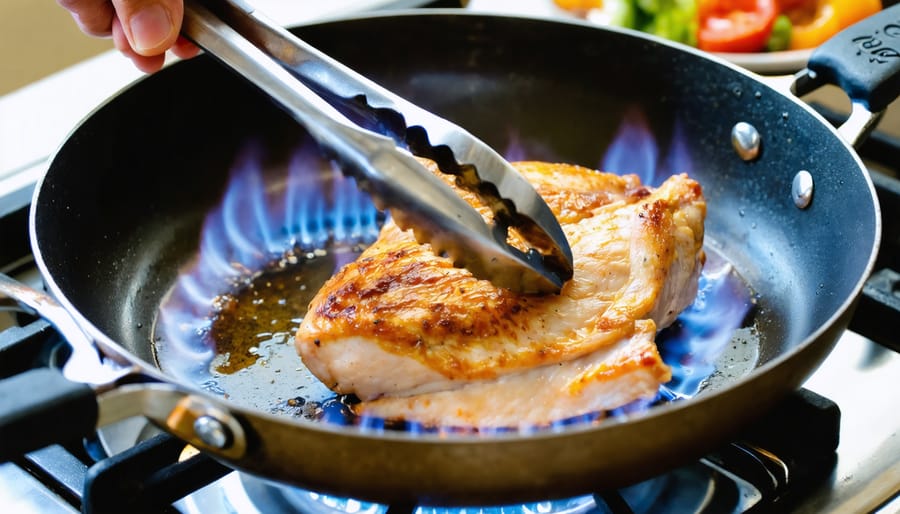Your GE electric stove’s Sensi-Temp technology is constantly monitoring your cooktop temperature to prevent dangerous grease fires before they start. This federally-mandated safety feature automatically limits burner temperatures to 400°F, cutting power when cookware reaches unsafe levels and preventing the 158,000 cooking fires that occur in American homes each year.
Think of Sensi-Temp as a vigilant guardian for your kitchen, similar to how proper ventilation and safety measures protect your living spaces from heating hazards. The technology uses sensors embedded in your burner elements to detect temperature spikes that typically lead to oil ignition. When temperatures climb too high, the system cycles power on and off to maintain safe cooking conditions without completely shutting down your burner.
While some home cooks initially worry this feature might disrupt high-heat cooking techniques like searing or stir-frying, understanding how Sensi-Temp works helps you adapt your cooking style rather than fight against it. The technology doesn’t prevent you from achieving beautifully caramelized results or perfectly seared proteins. Instead, it requires slight adjustments to timing and technique, much like learning to work with any new appliance in your home.
This innovation represents a significant shift in kitchen safety standards, bringing the same peace of mind to your cooking space that modern safety features provide throughout your home. Whether you’re a current owner adjusting to the technology or a potential buyer evaluating your options, knowing how Sensi-Temp functions empowers you to cook confidently while protecting your family and property.
What Makes Sensi-Temp Different From Traditional Electric Stoves
Traditional electric stoves operate on a straightforward principle: when you turn the dial, the heating element gets hot and stays at whatever temperature you set. While this gives you direct control, it also means those burners can reach dangerously high temperatures without any built-in safety limits. A conventional burner on the highest setting can easily exceed 900 degrees Fahrenheit, hot enough to ignite cooking oils, dish towels, or food residue in seconds.
This unlimited heating capability creates real risks in busy kitchens. We’ve all experienced those moments of distraction—a phone call, helping kids with homework, or simply stepping away for what you think is just a minute. With traditional stoves, that brief absence can lead to smoke, flames, and potential disaster.
Sensi-Temp technology fundamentally changes this equation by introducing intelligent temperature management. Instead of allowing unlimited heating, Sensi-Temp elements continuously monitor their surface temperature. When the sensor detects temperatures approaching the ignition point of cooking oils (around 400-450 degrees Fahrenheit), the system automatically cycles the burner to prevent it from climbing higher.
Think of it like the difference between an open fireplace and a modern gas insert with safety controls. Both provide heat, but one includes protective measures that respond automatically to dangerous conditions. You still control your cooking temperature through the dial settings, but the technology acts as a vigilant guardian, preventing those extreme temperature spikes that lead to kitchen fires.
This approach doesn’t eliminate heat—your stove still gets plenty hot for searing, boiling, and high-temperature cooking. It simply puts a sensible ceiling on how hot the surface can become, creating a safer cooking environment without sacrificing performance.
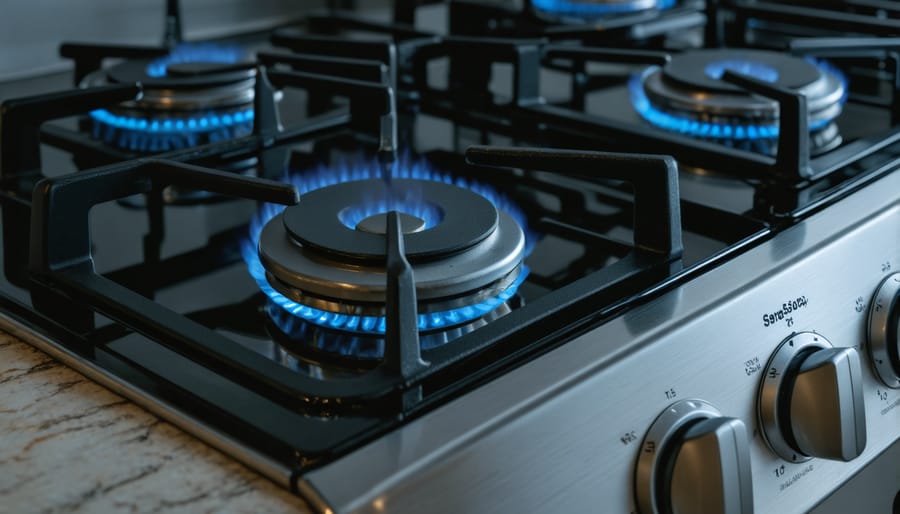
How Sensi-Temp Technology Actually Works
The Temperature Threshold That Saves Lives
GE chose the 350°F threshold after extensive research into cooking oil ignition points and real-world cooking patterns. This temperature represents a sweet spot where everyday cooking remains wonderfully effective while keeping your kitchen genuinely safe. Think of it as a protective boundary that works quietly in the background, much like how a fireplace screen protects your living space without diminishing the warmth.
Here’s what makes this number so important: most cooking oils begin smoking between 350°F and 400°F, and they can ignite around 500°F to 600°F. When oil reaches these dangerous temperatures, it releases vapors that can burst into flames with little warning. By capping the burner temperature at 350°F, Sensi-Temp technology prevents your cookware from ever reaching that critical ignition zone, even if you accidentally leave a pan unattended.
You might wonder if this limit affects your cooking abilities. The good news is that 350°F allows you to sauté, simmer, and prepare most dishes beautifully. You can still achieve that perfect golden sear on chicken or create delicious stir-fries. The technology simply removes the extreme heat levels that cause kitchen fires while preserving the cooking temperatures you actually use day-to-day, creating a safer home environment for your family.
What Happens When You Cook With Sensi-Temp
Most of the time, you won’t even notice Sensi-Temp is there. When you’re sautéing vegetables or simmering a sauce, the technology works quietly in the background, keeping an eye on surface temperatures while you focus on creating delicious meals for your family.
Here’s what typically happens: You place your pan on the burner and turn the heat to your desired setting, just like you always would. The burner heats up normally, responding to your adjustments as expected. Your food cooks beautifully, and everything feels perfectly familiar.
The magic happens when something goes wrong. Let’s say you get distracted by a phone call or forget to turn down the heat after bringing water to a boil. As the pan temperature climbs toward unsafe levels, Sensi-Temp automatically begins reducing power to the burner. You might notice the heat backing off slightly, or you might not notice anything at all until you return to find your pan warm but not dangerously overheated.
This invisible safety net means you’re protected from the most common cause of cooking fires without sacrificing control over your everyday cooking. The technology respects your cooking style while quietly standing guard, much like having a safety screen protects your living space near a fireplace without interfering with its warmth and ambiance.
The Real-World Kitchen Safety Benefits
Kitchen safety deserves the same thoughtful attention we give to fireplace safety, and GE’s Sensi-Temp technology brings that level of protection to your cooktop. Just as we carefully monitor open flames and install proper screens around hearths, preventing stovetop fires creates a comprehensive safety ecosystem in your home.
For families with young children, this technology offers invaluable peace of mind. We all know how quickly curious hands can reach toward hot surfaces or accidentally turn knobs. Sensi-Temp acts as a guardian, preventing temperatures from reaching dangerous levels even if little ones manage to access the controls. It’s similar to having a fireplace gate—a layer of protection that works automatically without requiring constant vigilance.
Elderly family members benefit enormously from this feature. As we age, memory lapses become more common, and the consequences of leaving a pot unattended can be devastating. The technology recognizes when a pan is overheating and intervenes before smoke or flames develop. This allows seniors to maintain their independence in the kitchen with reduced risk, much like how gas fireplaces offer warmth without the physical demands of wood-burning alternatives.
Busy multitaskers will appreciate having technology that watches over things when attention gets divided. Whether you’re helping with homework, answering a work call, or simply stepping outside, Sensi-Temp prevents the common scenario of a burner stuck on high from becoming a fire hazard.
The statistics speak volumes: cooking equipment causes nearly half of all home fires. By addressing this vulnerability, you’re creating a safer environment that complements all your other safety measures, from smoke detectors to properly maintained heating appliances. It’s about building layers of protection throughout your home.
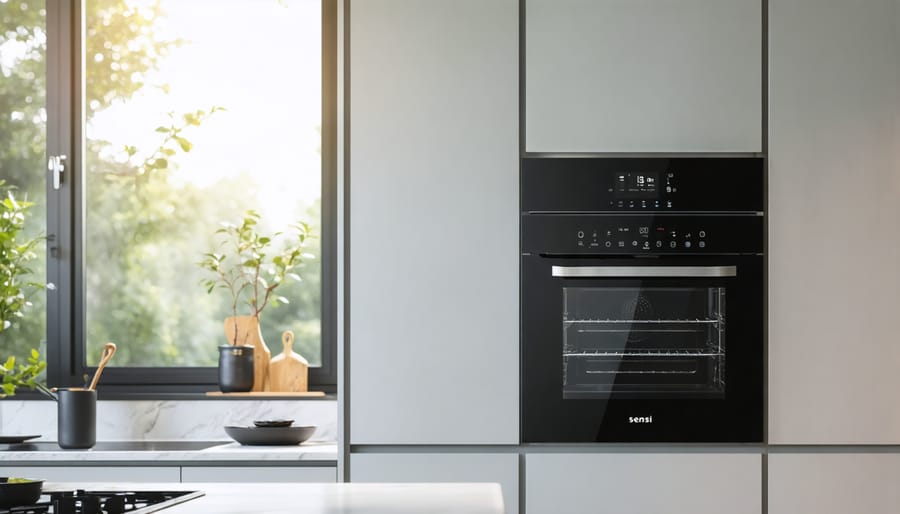
Does Sensi-Temp Change How You Cook?
Cooking Tasks That Work Perfectly
The good news is that Sensi-Temp technology works beautifully with most everyday cooking tasks. Boiling water for pasta, steaming vegetables, and warming up leftovers all perform exactly as you’d expect. The temperature limit rarely comes into play during these common activities, making the safety feature essentially invisible for routine meal preparation.
Simmering soups, sauces, and stews works wonderfully with this technology. The controlled heat actually helps prevent scorching and maintains consistent temperatures without constant monitoring. Sautéing vegetables and pan-frying at moderate temperatures also perform flawlessly, giving you the control you need while keeping your kitchen safer.
Even baking on the stovetop, like making pancakes or grilled sandwiches, remains perfectly achievable. Think of Sensi-Temp as a thoughtful assistant that watches over your cooking, stepping in only when temperatures reach potentially dangerous levels. For the vast majority of home cooking tasks, you’ll barely notice it’s there.
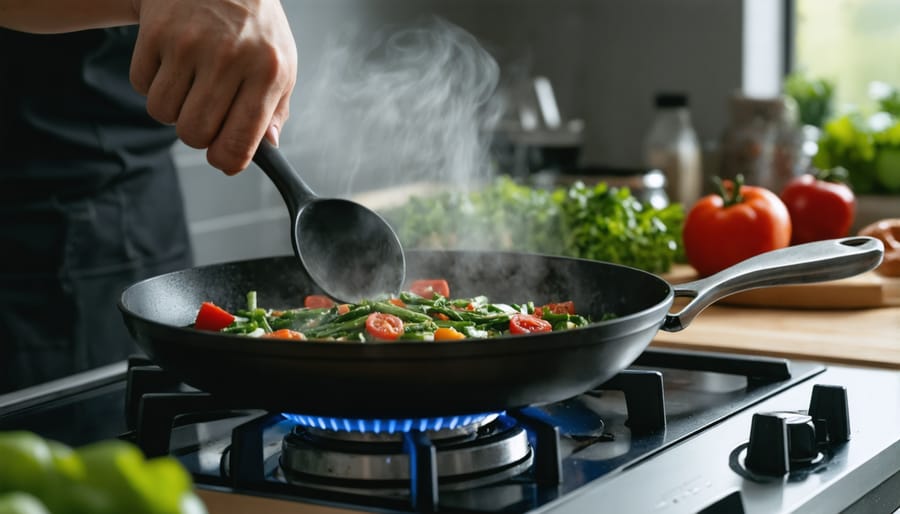
When You Might Notice the Difference
Let’s be honest: if you’re someone who loves creating restaurant-quality seared steaks with that perfect crust or frequently cooks with a wok on high heat, Sensi-Temp technology will require some adaptation. The system is designed to prevent fires by limiting surface temperature to 350°F, which sits below the sweet spot for traditional high-heat searing (typically 400-450°F).
You’ll notice the difference most when trying techniques that rely on sustained extreme heat. That beautifully caramelized crust on your ribeye might take a bit longer to develop, and wok cooking won’t quite achieve the same rapid-fire intensity you’d get at your favorite Chinese restaurant.
The good news? There are practical workarounds. Preheat your pan for a few extra minutes to maximize heat retention. Use cast iron cookware, which holds temperature better than thinner pans. For steaks, pat them completely dry before cooking and avoid overcrowding the pan, which helps compensate for the slightly lower heat.
Think of it like adjusting to any safety feature in your home. Just as modern fireplaces balance ambiance with responsible heating, Sensi-Temp balances cooking performance with meaningful fire prevention. Most everyday cooking, from sautéing vegetables to making pancakes, won’t feel different at all.
Understanding UL 858 and Why This Technology Matters Now
In December 2021, a significant shift occurred in home kitchen safety when UL 858, the updated Underwriters Laboratories standard for household electric ranges, took effect. This new requirement mandates that all electric coil and smooth-top ranges manufactured after this date must include technology to prevent cooking fires—which is where Sensi-Temp comes in.
The standard emerged from concerning statistics: cooking equipment is the leading cause of home fires in the United States, with unattended stovetops being a primary culprit. Just as we carefully consider safety features when selecting heating sources for our living spaces, kitchen fire prevention deserves the same attention. UL 858 addresses this by requiring temperature-limiting technology that prevents cookware from exceeding approximately 350°F on the highest burner setting, significantly reducing the risk of oil ignition and cooking fires.
For homeowners shopping for new electric stoves, this means Sensi-Temp or equivalent technology is now standard—not optional. If you’re replacing an older model, you’ll notice this feature on virtually all new electric ranges from major manufacturers. While some cooks initially worried about limitations, the technology is designed to maintain normal cooking performance for most everyday tasks while providing crucial protection against dangerous overheating.
This safety advancement reflects a broader commitment to making our homes safer, protecting families from preventable fires while maintaining the cooking experience you’ve come to expect from your kitchen.
Maintaining Your Sensi-Temp Stove for Optimal Performance
Keeping your Sensi-Temp stove in top condition ensures both safety and optimal cooking performance for years to come. Think of it like maintaining your home’s heating system—regular care prevents problems and keeps everything running smoothly.
The temperature sensors are the heart of this safety technology, so keeping them clean is essential. After each use, once the cooktop has completely cooled, gently wipe the element surface with a soft, damp cloth. Avoid abrasive cleaners or scrubbing pads that could damage the sensors. For stubborn spills, a mild dish soap solution works well. For more detailed cleaning recommendations, follow proper techniques that protect the sensor components while removing buildup that could interfere with temperature readings.
Choosing the right cookware makes a significant difference. Flat-bottomed pots and pans with good heat conduction work best with Sensi-Temp elements. Warped or uneven cookware can create air gaps that trigger the sensors unnecessarily, leading to frustrating cooking experiences. Medium to heavy-weight pans distribute heat more evenly and help the technology function as designed.
If you notice your burner cycling more frequently than expected, check that your pan sits flat on the element. Ensure nothing is trapped between the cookware and the heating surface. Sometimes what seems like a malfunction is simply the system doing its job—protecting your home from potential hazards.
The eco-friendly benefit here is substantial: a well-maintained stove operates more efficiently, using less energy while providing consistent results. Just as you’d maintain your fireplace for both safety and performance, giving your Sensi-Temp stove regular attention ensures it remains a reliable, protective feature in your kitchen for the long haul.
Just as modern fireplace technology has transformed how we safely enjoy warmth and ambiance in our living spaces, GE’s Sensi-Temp technology represents a meaningful leap forward in kitchen safety. Think about it: we’ve embraced automatic dampers, glass doors, and advanced ventilation systems in our fireplaces without hesitation because we understand they protect our homes and families. Sensi-Temp deserves the same enthusiastic adoption.
Yes, you might need to adjust your cooking techniques slightly, particularly with high-heat tasks like searing or wok cooking. But these minor adaptations pale in comparison to the peace of mind you’ll gain knowing your stovetop actively works to prevent kitchen fires. It’s a trade-off that makes sense for creating the safe, comfortable home environment you’ve worked hard to build.
As you invest in creating a cozier, more secure living space, whether through a beautiful fireplace installation or upgraded kitchen appliances, remember that true comfort comes from knowing your home protects those you love. Sensi-Temp isn’t just a regulatory requirement; it’s an invitation to cook with confidence, knowing this smart technology stands guard while you focus on preparing meals that bring your family together.

